Standard sightseeing course on the day of Hyakumangoku Parade (for those who want to avoid traffic restrictions)
The day you planned your trip to Kanazawa happens to be the day of the Hyakumangoku Procession! This is a model course for those who would rather do ordinary sightseeing than see the annual festival.
On the day of the Hyakumangoku Parade, the procession route in the center of the city will be closed to traffic, and local buses will operate on a temporary schedule and detour routes, so we will show you a course that will take you around the standard tourist spots avoiding the traffic restrictions.
For details, please see the Kanazawa Hyakumangoku Festival page.
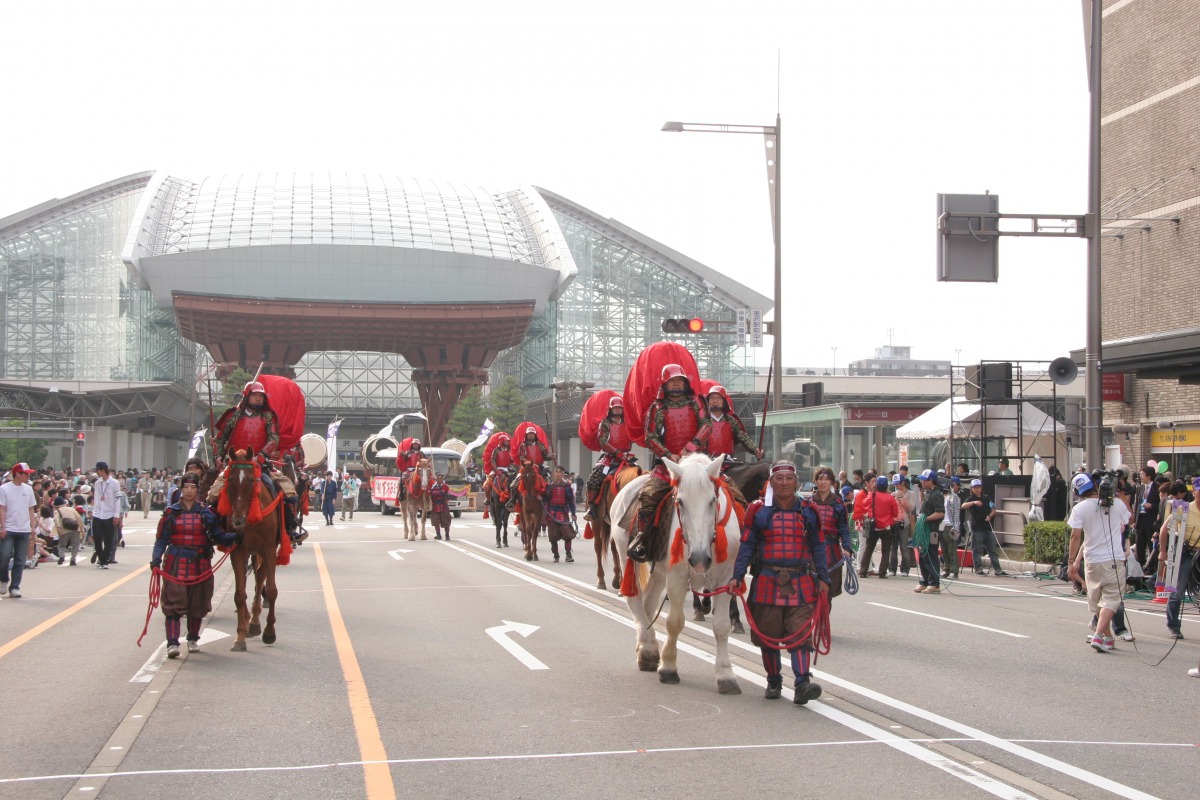
9:30 Kanazawa Station
The "Motenashi Dome" at the Kenrokuen exit of Kanazawa Station was designed with the concept of "hospitality," symbolizing offering an umbrella to travelers arriving at the station in a region known for its frequent rain and snow. Visitors are welcomed by the geometric-patterned glass ceiling.
A popular photo spot is the majestic "Tsuzumi-mon" Gate, inspired by the tsuzumi drums used in Kanazawa's traditional Noh theater. Standing at 13.7 meters tall, the grand structure, supported by two sturdy pillars, is truly impressive. Many tourists stop here first to take commemorative photos. Kanazawa Station is even recognized as one of the 14 most beautiful stations in the world.
From sunset to midnight, the is "Tsuzumi-mon" Gate lluminated. Every hour, on the hour, for 2 minutes, it lights up in colors representing the five traditional Kaga colors (crimson, indigo, grass green, ocher, and ancient purple), with different colors showcased each weekday (Monday: crimson, Tuesday: indigo, Wednesday: grass green, Thursday: ocher, Friday: ancient purple). On weekends and holidays, all five colors are displayed for 2 minutes each. Be sure to visit during nighttime to enjoy the magical lighting!
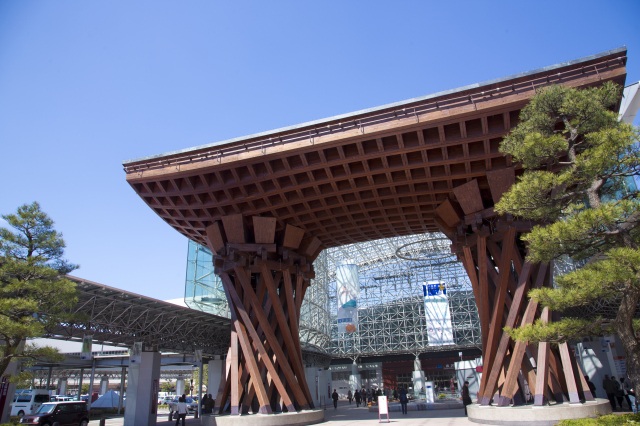
Get off at "Musashigatsuji & Omicho market" bus stop.
Boarding time: approx. 5 minutes
10:00 Omicho Market Sightseeing and shopping (approx. 40 minutes)
Discover Kanazawa’s most famous fish market
Established during the Edo Period, Omicho Market has formed an essential part of Kanazawa’s food culture for more than 300 years.
The sprawling market features more than 170 stores, including a large number of fishmongers that sell freshly caught seafood from the Sea of Japan. There are also fruit and vegetables stores that sell unique local produce, marine product stores, clothing stores, grocery stores and restaurants.
Particularly well-revered are the crab, yellowtail and shrimp from the Sea of Japan that are sold around November. Because of this, the market is normally crowded with tourists and locals alike during this time of year.
Another key attraction of the market is Omicho Ichibakan. The refurbished building features a number of popular restaurants and stores that are worth stopping by during your trip to the market.
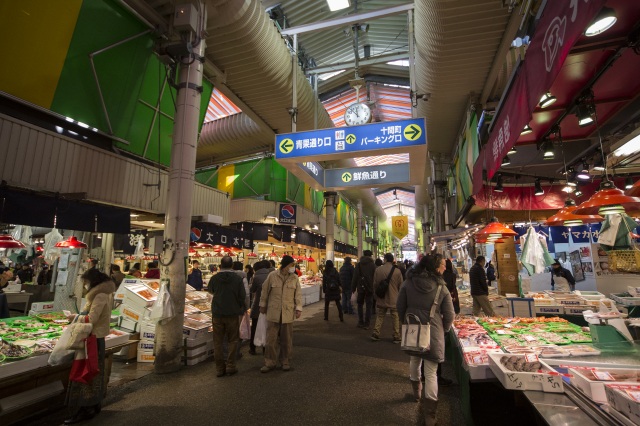
Boarding time: approx. 5 minutes
11:00 Nagamachi District
A stunningly preserved samurai district in the center of Kanazawa
Kanazawa was once the economic and administrative center of the Kaga Domain (feudal-era Ishikawa Prefecture). Over the course of the Edo period, it grew rapidly – its population growing to over 100,000 – transforming it into one of the largest castle towns in feudal Japan. Its population rivaled that of Rome and Madrid at the time.
With the castle at its center, the town was designed with both its defensive and economic aspects in mind. Members of the upper classes were often given allotments of land for their residences close to that of the feudal lord (daimyo) in the castle, while commoners lived near the town’s edges.
Nagamachi Samurai District, located near the center of town, was where the middle to high-ranking samurais lived – which is why it’s sometimes described as the city’s samurai district. Nagamachi literally means “Long Town,” though it’s more likely that it actually takes its name from the surname of a local family, the Cho, which means “long” which can also be pronounced “naga.”
Nagamachi Samurai District’s historical value lies in its unusual state of preservation. It has escaped large-scale fires, including the firebombing that damaged other large cities such as Tokyo and Osaka during World War II. Accordingly, it retains many features from the Edo period: narrow streets, a drainage and water supply system that remains in use, and restored samurai houses.
Many of these residences maintain their original earthen walls (tsuchi-kabe), which are still covered in the winter with straw mats to protect them from frost and subsequent cracking. A walk through Nagamachi, where an Edo-period atmosphere still lingers, offers a glimpse into the heritage of Kanazawa and Japan.
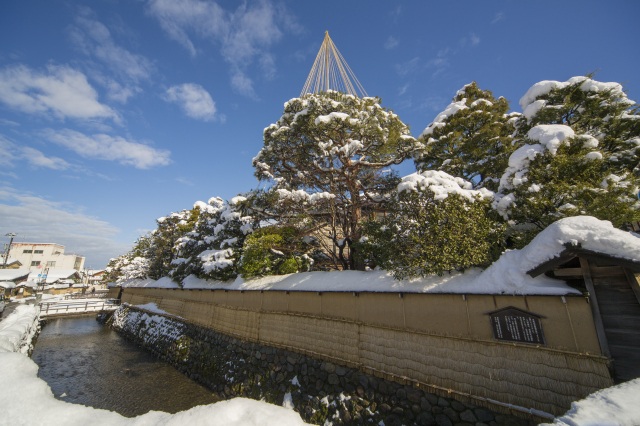
12:30 21st Century Museum of Contemporary Art, Kanazawa (Approx. 1hour)
A hub for contemporary art in Kanazawa
Opened in 2004, the 21st Century Museum of Contemporary Art in Kanazawa stands out compared to more traditional art museums. The museum features a captivating disc-like design, as if it were a UFO touching down in the middle of Kanazawa. All the walls are made of glass and the building features five gates, all pointing towards different parts of the city.
The museum exhibits experimental contemporary art that visitors can touch or sit on and is perfect for children and adults alike. Some of museum’s highlights include commissioned works, which are integrated into the building’s unique design.
The 21st Century Museum of Contemporary Art excels at offering visitors unique experiences that can’t be found anywhere else. Highlights include Leandro Erlich's The Swimming Pool, which enables visitors to feel as if they’re standing at the bottom of a swimming pool, and a wall decorated with flowers gathered from the suburbs of Kanazawa.
Additionally, the museum's shop offers a wide variety of products, such as museum memorabilia, accessories, and selected goods.
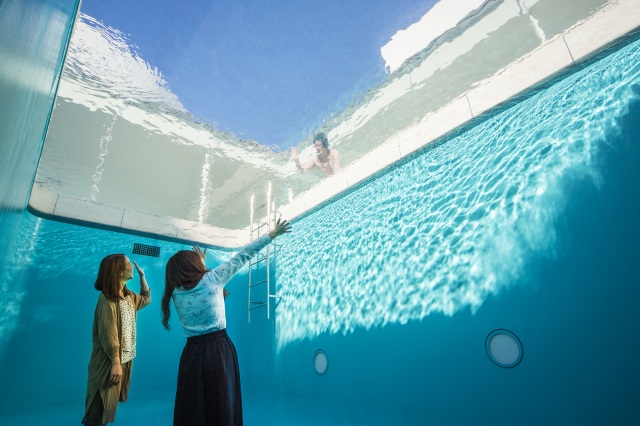
3 minutes walk
13:30 Kenrokuen Garden (Approx. 80minutes)
A Beautiful and Famous Garden in the Heart of Kanazawa
Considered one of Japan’s three most beautiful gardens, Kenrokuen Garden is a must-visit location in Kanazawa. The name Kenrokuen means “having six factors”, representing the attributes which bring out the garden’s stunning beauty: spaciousness, tranquility, artifice, antiquity, water sources and magnificent views.The garden has an area of 11.4 hectares and is located on the heights of the central part of Kanazawa next to Kanazawa Castle. The Maeda family, who ruled the Kaga Domain (the present Ishikawa and Toyama areas) in feudal times, maintained the garden from generation to generation. It is regarded as one of the most beautiful feudal lords' gardens in Japan.
One of Kenrokuen Garden’s most stunning attractions is its large artificial pond called Kasumigaike. Located near the center of the pond is Horai Island. The pond is often seen to symbolize the sea and Horai Island a sacred island out at sea, on which an ageless hermit with miraculous power was believed to live. As a result, the pond and the island were constructed to symbolize long life and eternal prosperity for the lord.
There are many other gorgeous features to enjoy in the garden, including the flowers and trees that grow there, such as plum and cherry blossoms in spring, azaleas and irises early in summer, and colorful red and yellow leaves in autumn.
In Winter, visitors can enjoy the snow-covered landscapes with yukitsuri (which means “snow hanging”). yukitsuri is a traditional technique for protecting the branches of the pine trees in the garden from heavy snow; trees are given support by bamboo poles and rope arranged a captivating conical layout.
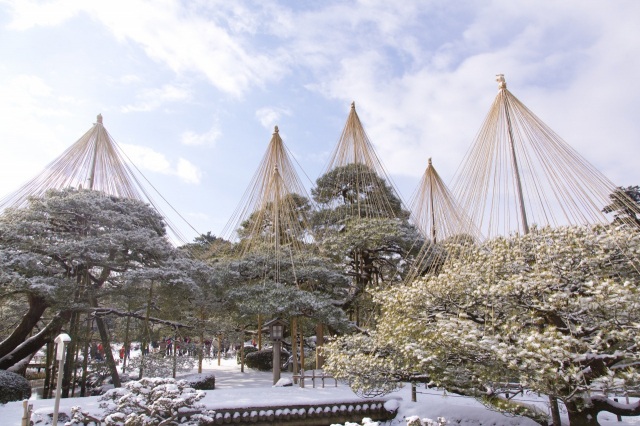
or 15 minutes on foot
15:00 Higashi Chaya District (Approx. 80 minutes)
Discover one of Kanazawa’s largest geisha districts
In Japanese culture, geisha houses have been traditional places for feasts and entertainment since the Edo period. Also referred to as “chaya”, they are where geishas entertained wealthy nobility and rich merchants. Geishas are female Japanese entertainers who perform dances and play traditional Japanese instruments.
The central part of Kanazawa was once dotted with a number of geisha houses, but in 1820, these were moved to three specific districts away from the city centre. The largest one of these – and arguably the most famous – is the Higashi Chaya district.
The geisha houses in Higashi Chaya have a stunning traditional appearance. A geisha house is characterised by the beautiful lattice on the outer side of its first floor, called “kimusuko”, and the Japanese-style guestrooms located on the second floor. During the Edo period, the construction of two-story buildings except geisha houses was prohibited, making their appearance all the more striking.
These historical geisha houses along with Kyoto's Gion and Kanazawa's Kazue-machi have been designated as Japanese cultural assets. No other geisha districts have been designated as cultural assets for Japan, making Higashi Chaya even more special.
The district includes facilities where you can see the interior of a geisha house that was built almost 200 years ago, as well as quite a few old buildings have been refurbished into restaurants, cafes, and souvenir shops. Additionally, it takes a mere three minutes on foot to reach the banks of the Asano River from Higashi Chaya, making it an excellent area to explore afterwards.
The Kanazawa City Tourism Association holds a geisha performance show in the three geisha districts of the city on designated Saturdays, so make sure you plan your visit accordingly.
Click here for stores in Higashi Chaya District where you can use the special Gourmet Ticket Kanazawa Bimi.
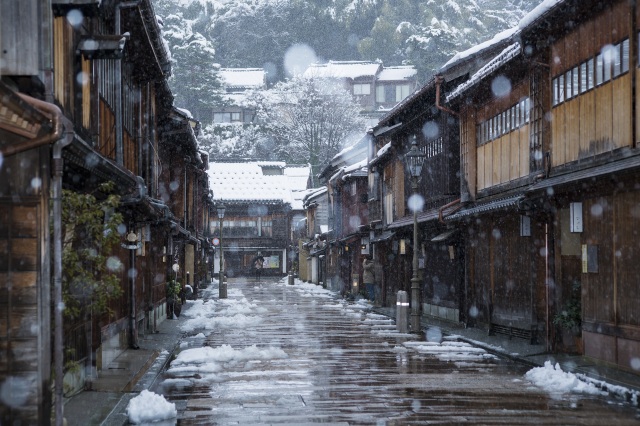
(*Buses will take longer than usual due to a detour route on a temporary schedule.
17:00 Kanazawa Station
The "Motenashi Dome" at the Kenrokuen exit of Kanazawa Station was designed with the concept of "hospitality," symbolizing offering an umbrella to travelers arriving at the station in a region known for its frequent rain and snow. Visitors are welcomed by the geometric-patterned glass ceiling.
A popular photo spot is the majestic "Tsuzumi-mon" Gate, inspired by the tsuzumi drums used in Kanazawa's traditional Noh theater. Standing at 13.7 meters tall, the grand structure, supported by two sturdy pillars, is truly impressive. Many tourists stop here first to take commemorative photos. Kanazawa Station is even recognized as one of the 14 most beautiful stations in the world.
From sunset to midnight, the is "Tsuzumi-mon" Gate lluminated. Every hour, on the hour, for 2 minutes, it lights up in colors representing the five traditional Kaga colors (crimson, indigo, grass green, ocher, and ancient purple), with different colors showcased each weekday (Monday: crimson, Tuesday: indigo, Wednesday: grass green, Thursday: ocher, Friday: ancient purple). On weekends and holidays, all five colors are displayed for 2 minutes each. Be sure to visit during nighttime to enjoy the magical lighting!
